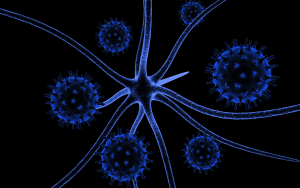While uncommon, viral infections of the brain “can lead to transient or permanent neurologic or psychiatric dysfunction” (van den Pol, 2009). The effects of COVID-19 on the human brain is yet to be thoroughly researched. Research has found that “patients with COVID-19 often suffer from severe hypoxia and viremia, which has the potential to cause toxic encephalopathy” and that “40% of patients with COVID-19 develop a headache, disturbed consciousness, and other brain dysfunction symptoms” (Wu et al., 2020). Viruses can have a wide range of neurological effects, but it is perhaps the most apropos to review other varieties of coronaviruses.
 Mouse hepatitis virus (MHV) causes encephalitis in mice, despite the canonical receptor being “poorly expressed in mice brains” (Phillips, Kuo, Richardson & Weiss, 2012). MHV also causes demyelination in neurons which leads to neurological problems due to the slowing or stopping of nerves as well as bladder complications similar to those in cases of multiple sclerosis (Lavi, Das Sarma, & Weiss, 1999; Lee et al., 2019).
Mouse hepatitis virus (MHV) causes encephalitis in mice, despite the canonical receptor being “poorly expressed in mice brains” (Phillips, Kuo, Richardson & Weiss, 2012). MHV also causes demyelination in neurons which leads to neurological problems due to the slowing or stopping of nerves as well as bladder complications similar to those in cases of multiple sclerosis (Lavi, Das Sarma, & Weiss, 1999; Lee et al., 2019).
Thus far, there has been one case of intracerebral hemorrhage in a COVID-19 patient (Sharifi-Razavi, Karimi,& Rouhani, 2020). In regards to this case and anecdotal reports regarding lack of smell and extrapulmonary symptoms researchers suggest further investigation into the hypothesis that “COVID-19 directly invades the central nervous system via the olfactory receptors of cranial nerve I in the nasal cavity cell membrane” (Sharifi-Razavi, Karimi,& Rouhani, 2020). Again, there is only limited research on COVID-19 to suggest how it could potentially affect the human brain, but as the pandemic progresses understanding all aspects of the disease will be vital.
Like neurodegenerative diseases, viruses “can induce alterations and degenerations of neurons both directly and indirectly” (Zhou, Miranda-Saksena & Saksena, 2013). There are two theories explaining how viruses enter the central nervous system (CNS): “one is hematogenous dissemination and the other is neuronal retrograde dissemination” (Zhou, Miranda-Saksena & Saksena, 2013). Viruses enter the brain by crossing the blood-brain barrier or they enter through nerves via the brain stem (Zhou, Miranda-Saksena & Saksena, 2013). Though the CNS is immune privileged, some immune and inflammatory responses still occur (Zhou, Miranda-Saksena & Saksena, 2013). Inflammatory responses clean damaged tissue and minimize required repairs, but viruses instead lead to chronic inflammation due to increased oxidative and nitrosative stress (Zhou, Miranda-Saksena & Saksena, 2013). Chronic inflammation forms a self-perpetuating inflammatory cycle and is “highly detrimental to long term neuronal survival” (Zhou, Miranda-Saksena & Saksena, 2013). Oxidative stress is a major cause and consequence of neuroinflammation. It is also “one of the main features of neurodegenerative diseases as it binds all neurological and neurodegenerative diseases together” (Zhou, Miranda-Saksena & Saksena, 2013).
Inflammation in the brain is also known as encephalitis (National Institute of Neurological Disorders and Stroke, 2020). Herpes simplex encephalitis is responsible for 10% of encephalitis cases each year and a greater than 50% fatality rate in untreated cases (National Institute of Neurological Disorders and Stroke, 2020). Other common viral forms of encephalitis include Equine encephalitis, LaCrosse encephalitis, St. Louis encephalitis, and West Nile encephalitis (National Institute of Neurological Disorders and Stroke, 2020). Individuals with encephalitis experience flu-like symptoms in mild cases, while more severe cases may experience, “problems with speech or hearing, double vision, hallucinations, personality changes, and loss of consciousness, loss of sensation in some parts of the body, muscle weakness, partial paralysis in the arms and legs, impaired judgment, seizures, and memory loss” (National Institute of Neurological Disorders and Stroke, 2020).
Viral encephalitis is treated with antiviral medications such as acyclovir, but occasionally requires breathing assistance, intravenous fluid intake, and anti-inflammatory drugs (Venkatesan & Geocadin, 2014). Remdesivir has been proposed as an antiviral treatment for COVID-19 (Al-Tawfiq, Al-Homoud & Memish, 2020). There is currently no vaccine for COVID-19
Overall, research on how COVID-19 affects the brain is still developing. There is a reason to suspect the risk of infection and inflammation, but consistent research is needed to confirm emerging studies (Wu et al., 2020). HBSF is currently committed to researching rapid testing in conjunction with ni2o, but will also attempt to develop research supporting diagnostics of neurodegenerative diseases. Ni2o’s diagnostic testing could be utilized to better understand how COVID-19 interacts with the human brain, and neurodegenerative diseases in the near future. If you are interested in supporting HBSF’s research towards COVID-19 efforts, you can donate here. Lastly, as these are trying times, our patient advocacy group is continuously available to help and can be reached at patientadvocacy@brainsciences.org
Written by Senia Hardwick
References
Al-Tawfiq, J. A., Al-Homoud, A. H., & Memish, Z. A. (2020). Remdesivir as a possible therapeutic option for the COVID-19. Travel Medicine and Infectious Disease. https://doi.org/10.1016/j.tmaid.2020.101615
Lee, S., Nedumaran, B., Hypolite, J., Caldwell, B., Rudolph, M. C., & Malykhina, A. P. (2019). Differential neurodegenerative phenotypes are associated with heterogeneous voiding dysfunction in a coronavirus-induced model of multiple sclerosis. Scientific Reports, 9(1), 10869. https://doi.org/10.1038/s41598-019-47407-x
National Institute of Neurological Disorders and Stroke. (2020). Meningitis and encephalitis fact sheet. https://www.ninds.nih.gov/Disorders/Patient-Caregiver-Education/Fact-Sheets/Meningitis-and-Encephalitis-Fact-Sheet
Phillips, J. M., Kuo, I.-T., Richardson, C., & Weiss, S. R. (2012). A novel full-length isoform of murine pregnancy-specific glycoprotein 16 (Psg16) is expressed in the brain but does not mediate murine coronavirus (Mhv) entry. Journal of Neurovirology, 18(2), 138–143. https://doi.org/10.1007/s13365-012-0081-6
Sharifi-Razavi, A., Karimi, N., & Rouhani, N. (2020). COVID-19 and intracerebral haemorrhage: Causative or coincidental? New Microbes and New Infections, 35, 100669. https://doi.org/10.1016/j.nmni.2020.100669
van den Pol, A. N. (2009). Viral infection leading to brain dysfunction: More prevalent than appreciated? Neuron, 64(1), 17–20. https://doi.org/10.1016/j.neuron.2009.09.023
Venkatesan, A., & Geocadin, R. G. (2014). Diagnosis and management of acute encephalitis. Neurology: Clinical Practice, 4(3), 206–215. https://doi.org/10.1212/CPJ.0000000000000036
Wu, Y., Xu, X., Chen, Z., Duan, J., Hashimoto, K., Yang, L., Liu, C., & Yang, C. (2020). Nervous system involvement after infection with COVID-19 and other coronaviruses. Brain, Behavior, and Immunity. https://doi.org/10.1016/j.bbi.2020.03.031
Zhou, L., Miranda-Saksena, M., & Saksena, N. K. (2013). Viruses and neurodegeneration.
Virology Journal, 10, 172. https://doi.org/10.1186/1743-422X-10-172
